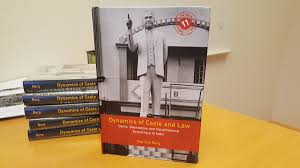
Main ideas from Prof Dag Eric Berg’s talk on ‘Dynamics of Caste and Law in India’
Summarized by – Nioshi
In this talk, Prof Dag Eric Berg discusses concepts introduced in his upcoming book ‘Dynamics of Caste and Law in India’. His book aims to answer one major question: ‘How does one explain that caste-based oppression persists in a liberal democracy?’
Discussions on Caste and Law
- Caste and law are two diverse topics. The concept of ‘caste’ has many dimensions to it, such as marriage, property, reservation, religion, and social relations. Similarly, ‘law’ has various dimensions to it, such as constitutional law, civil law, criminal law, all having different procedures.
- Many people question whether caste was abolished at the time of India’s independence. This, he says, is a naive question to ask, as caste was not abolished and still persists.
- Constituent Assembly debates on ‘untouchability’:
- ‘Untouchability’ was introduced as a debate in the constituent Assembly
- The discussions were regarding abolishing untouchability
- Questions on why they were trying to abolish only untouchability came up– as untouchability arises from caste. Hence, caste should be prohibited.
- Cause and Effect: If one abolishes untouchability, they are eliminating the effect rather than the cause. Issues pertaining to caste still remain.
- After observing discussions in the constituent assembly, one can know that only abolishing untouchability will not be adequate to protect Dalits from atrocities. Caste as a whole must be abolished.
Organic Scholars and their Concepts on Caste
- Du Bois
- He was not endorsed by dominant sociologists in the United States
- However, his concept of ‘double consciousness’ remains prevalent
2. Bhimrao Ambedkar
- Ambedkar’s concept of ‘graded inequality’ continues to resonate with the dimensions of caste
- Overall, research proves that there have been inadequate concepts to help understand the persistence of caste.
In his book titled ‘Dynamics of Caste and Law in India’, Berg develops two key concepts to explain caste-based oppression:
- ‘Mechanism of Oppression’
- First step/ starting point towards critical explanation
- It has been observed that even when people of the lower caste gain upward social mobility, atrocities against them do not reduce.
- This is the characterization of the Dalit situation in India
- ‘Grip of Caste’
- The ‘Essex School in Political Theory’ introduces psychoanalytical concepts which can be used to explain how caste grips onto certain subjects
- ‘Caste is a notion, it is a state of mind’: One way to make sense of ‘grip of caste’ is to understand Ambedkar’s ‘Annihilation of Caste’. Ambedkar says that the ‘real remedy’ to the caste problem is to have intercaste marriages. There is an element of social psychology in all of his writings.
- Berg explains this phenomenon by calling it the ‘ontological drive of caste’ or the ‘grip of caste’.
Main Conclusions of the Book
Visible topics in law
- Reservation
- Prevention of Atrocity Act
Less visible yet crucial topics of caste
- Endogamy- marriage within the caste
- Property and land reforms
- Caste grips subjects, and inequality and the belief in caste sustains over time
Some Questions:
What are the challenges of caste in becoming an international issue?
- Power and political reasons
- Knowledge distribution in academia, and lack of understanding
- State sovereignty: Indian government seems to be reluctant to have an international community exploring domestic issues in India
- Caste is a complex issue. While race can be understood through the concept of color, caste has many more complexities to it. Hence, it is more difficult to understand.
Why is Gender missing from the book?
- The material has been biased due to the author’s gender and the sample of interviewees who were mostly men
- However, the gender question is extremely important and central to the reproduction of caste
- It needs to be thought and researched further



+ There are no comments
Add yours